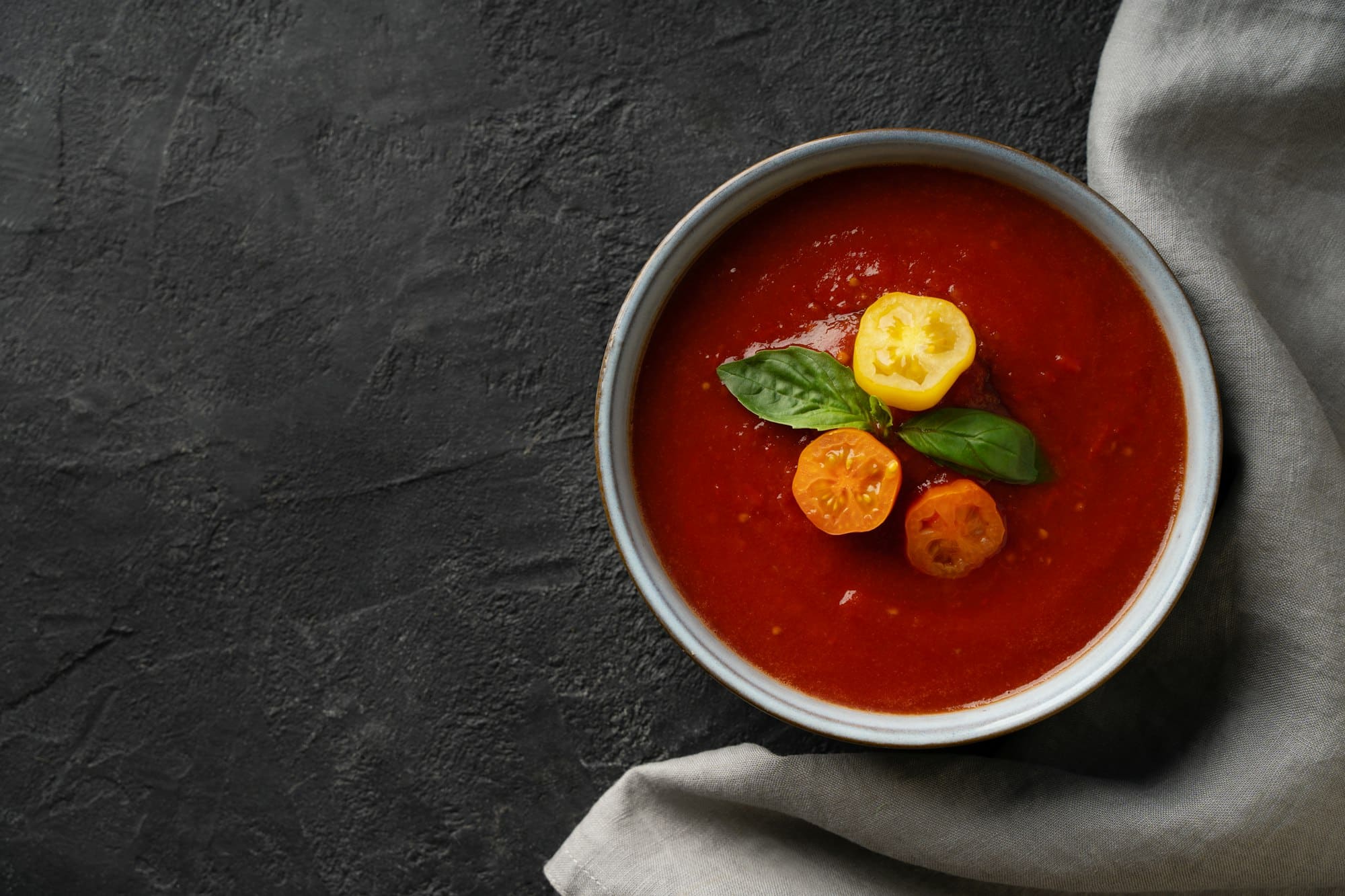What’s the Best Technique for Making Authentic Gourmet Gazpacho Andaluz?

Gazpacho, the classic Spanish soup, is a burst of summer in every spoonful. This chilled blend of ripe tomatoes, cucumber, bell pepper, oil, and vinegar is a tradition that traces back to Andalusia, the southernmost region of Spain. But what’s the secret behind making an authentic gourmet Gazpacho Andaluz? Let’s delve into the art of crafting this tangy, refreshing soup, and the best techniques to elevate the traditional recipe into a gourmet dish.
Mastering the Basics: Ingredients and Preparation
Every great dish begins with sourcing quality ingredients. For Gazpacho Andaluz, the main elements include ripe tomatoes, cucumber, green bell pepper, bread, garlic, extra virgin olive oil, vinegar, and salt. Maintaining the freshness and quality of these ingredients is imperative to capture the essence of the soup.
A lire aussi : How Can You Craft a Savory Gourmet Quiche Lorraine with a Flaky Crust?
With gazpacho, the recipe is straightforward, but the technique can make all the difference. Start by peeling the tomatoes. To do this, cut a small ‘x’ on the base of each tomato and blanch them in boiling water for 30 seconds. This will make the skin easily peel off. Then, core and de-seed the tomatoes.
The cucumber and bell pepper are also de-seeded. If you’re using traditional Spanish ‘pepinos’, peeling isn’t necessary, but for regular cucumbers, remove the peel to avoid a bitter taste.
A découvrir également : How to Perfect the Classic French Ratatouille with a Modern Gastronomic Twist?
The bread acts as a thickener. Ideally, use stale white bread, soaked in water for about ten minutes. After squeezing out the excess water, add it to the mix. The use of bread is an age-old technique to give the gazpacho its distinctive body and texture.
Blending to Perfection: The Art of Gazpacho
The gazpacho recipe follows a simple rule: blend everything together. But the key to a smooth, creamy soup lies in the blending technique.
Start by blending the tomatoes, cucumber, bell pepper, and garlic. Add the soaked bread and blend until you achieve a coarse consistency. Pour in the extra virgin olive oil gradually while blending, allowing the mixture to emulsify and gain a creamy texture. This technique is essential to avoid a watery gazpacho.
Next, add the vinegar and salt to taste. The vinegar adds the characteristic tang, while the salt enhances all the other flavors. Blend everything one last time.
Now, the most crucial step: strain the mixture. This will help remove any remaining solids and give your gazpacho a velvety finish. Straining might seem like an added effort, but it’s a fundamental step in achieving a gourmet gazpacho.
Cooling and Serving: A Matter of Time
Once your gazpacho is ready, it’s time for a chilling session. Refrigerate it for at least two hours, allowing the flavors to meld together. The cooling time makes a significant difference to the taste and texture of the soup, making it more refreshing and flavorful.
Serving gazpacho is an art too. In Spain, it’s traditionally served in a glass, not a bowl. Sometimes, finely chopped vegetables like cucumber, bell pepper, and tomato are added as garnish, offering a contrast of textures. A drizzle of olive oil just before serving gives it a glossy finish and enhances the flavor.
Elevating the Classic Gazpacho: Gourmet Touches
To transform the classic gazpacho into a gourmet dish, you can play around with the garnishes and additional flavors. Adding a dollop of avocado cream or a scoop of tomato sorbet can introduce an unexpected twist to the traditional recipe.
Gourmet gazpacho also means paying attention to the presentation. Serving it in a wine glass or a martini glass, garnished with fresh herbs or edible flowers, can elevate the simple soup to a dish worthy of a Michelin-star restaurant.
No matter how you choose to serve it, the essence of gazpacho lies in its refreshing simplicity and the quality of ingredients. Whether it’s a classic recipe or a gourmet version, the best gazpacho is the one made with love and patience, celebrating the flavors of ripe summer vegetables.
The Purity of Flavors: The Magic of Sherry Vinegar and Extra Virgin Olive Oil
For every gazpacho recipe, the most crucial ingredients are sherry vinegar and extra virgin olive oil. In fact, the use of these two elements can make or break your gazpacho, especially if you aim for a sophisticated, gourmet version.
Let’s start with sherry vinegar. This vinegar, produced in the Spanish province of Cadiz, is known for its unique sweet and tangy flavor. It adds an incredible depth to the gazpacho, enhancing the taste of ripe tomatoes and cucumbers. Some chefs even prefer using two types of vinegar – a milder one for blending and a stronger one for finishing. This way, the soup maintains a balanced acidity without overpowering other flavors.
Extra virgin olive oil, on the other hand, lends the gazpacho an unctuous texture and a rich, fruity flavor. The secret lies in the method of adding the oil. You should pour it in a slow, steady stream while the food processor is still running. This emulsifies the oil with the other ingredients, resulting in a creamy, luxurious soup rather than a watery one.
The quality of the oil is also fundamental. Go for an excellent Spanish extra virgin olive oil, which will add that authentic touch to your gazpacho. Remember, the better the oil, the better the gazpacho.
The Final Touches: Garnishing and Serving
Your gazpacho is almost ready. Now it’s time for the grand finale: garnishing and serving. Regarded as a cold soup, traditional gazpacho is typically topped with finely chopped vegetables like cucumber, red bell pepper, and red onion. This not only adds a delightful crunch but also makes the dish visually appealing.
But for a gourmet twist, consider more creative toppings. Try a spoonful of tomato sorbet for a chilly surprise, or a sprinkle of crispy bacon for a salty crunch. For a bit of heat, a dash of finely chopped jalapeños works wonders. Even a simple drizzle of high-quality extra virgin olive oil can bring out the flavors beautifully.
Gazpacho is traditionally served in a glass in Spain, as this enhances the soup’s refreshing quality. For a gourmet presentation, try serving it in a wine glass or a martini glass. You could also go for rustic charm with a mason jar.
Remember, the best gazpacho is not about complexity; it’s about celebrating simple, fresh ingredients. Whether it’s a classic Spanish gazpacho or a gourmet Gazpacho Andaluz, the secret lies in choosing excellent ingredients, mastering the technique, and, of course, adding a dash of love.
Conclusion: The Essence of the Best Gazpacho Andaluz
Whether you’re a seasoned chef or a home cook, creating an authentic gourmet Gazpacho Andaluz is an achievable feat. This traditional Spanish cold soup, with its vibrant flavors and refreshing character, is an ode to the summer’s bounty of ripe tomatoes, cucumbers, and bell peppers.
The best gazpacho recipe revolves around quality ingredients, especially the ripe tomatoes, extra virgin olive oil and sherry vinegar. The time—minutes spent meticulously peeling, de-seeding, blending, and chilling—also plays a significant role in the final outcome. The use of a food processor to achieve the perfect texture is crucial, as is the straining process, which gives the gazpacho its signature velvety finish.
The beauty of gazpacho lies in its flexibility. Feel free to experiment with garnishes, serving styles, and additional flavors. Whether you stick to a traditional recipe or venture into gourmet territory, remember to keep the essence of gazpacho alive—a simple, refreshing soup that celebrates the freshness of summer vegetables and the rich flavors of Spanish cuisine.
